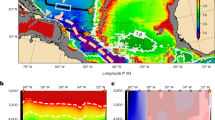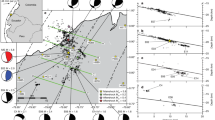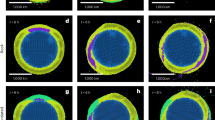Abstract
Saturn’s moon Enceladus is an active world. In 2005, the Cassini spacecraft witnessed for the first time water-rich jets venting from four anomalously warm fractures (called sulci) near its south pole1,2. Since then, several observations have provided evidence that the source of the material ejected from Enceladus is a large underground ocean, the depth of which is still debated3–6. Here, we report on the first and only opportunity that Cassini’s RADAR instrument7,8 had to observe Enceladus’s south polar terrain closely, targeting an area a few tens of kilometres north of the active sulci. Detailed analysis of the microwave radiometry observations highlights the ongoing activity of the moon. The instrument recorded the microwave thermal emission, revealing a warm subsurface region with prominent thermal anomalies that had not been identified before. These anomalies coincide with large fractures, similar or structurally related to the sulci. The observations imply the presence of a broadly distributed heat production and transport system below the south polar terrain with ‘plate-like’ features and suggest that a liquid reservoir could exist at a depth of only a few kilometres under the ice shell at the south pole. The detection of a possible dormant sulcus further suggests episodic geological activity.
This is a preview of subscription content, access via your institution
Access options
Access Nature and 54 other Nature Portfolio journals
Get Nature+, our best-value online-access subscription
$29.99 / 30 days
cancel any time
Subscribe to this journal
Receive 12 digital issues and online access to articles
$119.00 per year
only $9.92 per issue
Buy this article
- Purchase on Springer Link
- Instant access to full article PDF
Prices may be subject to local taxes which are calculated during checkout



Similar content being viewed by others
References
Porco, C. C. et al. Cassini observes the active south pole of Enceladus. Science 311, 1393–1401 (2006).
Spitale, J. N. & Porco, C. C. Association of the jets of Enceladus with the warmest regions on its south polar fractures. Nature 449, 695–697 (2007).
Postberg, F. Sodium salts in E-ring ice grains from an ocean below the surface of Enceladus. Nature 459, 1098–1101 (2009).
Collins, G. C. & Goodman, J. C. Enceladus’ south polar sea. Icarus 189, 72–82 (2007).
Iess, L. et al. The gravity field and interior structure of Enceladus. Science 344, 78–80 (2014).
Thomas, P. C. Enceladus’s measured physical libration requires a global subsurface ocean. Icarus 264, 37–47 (2016).
Elachi, C. RADAR: the Cassini Titan radar mapper. Space Sci. Rev. 115, 71–110 (2004).
Janssen, M. A. Titan’s surface at 2.2-cm wavelength imaged by the Cassini RADAR radiometer: calibration and first results. Icarus 200, 222–239 (2009).
Spencer, J. R. et al. Cassini encounters Enceladus: background and the discovery of a south polar hot spot. Science 311, 1401–1405 (2006).
Howett, C. J. A., Spencer, J. R., Pearl, J. & Segura, & M. High heat flow from Enceladus’ south polar region measured using 10–600 cm−1 Cassini/CIRS data. J. Geophys. Res. 116, E03003 (2011).
Hsu, H.-W. Ongoing hydrothermal activities within Enceladus. Nature 519, 207–210 (2015).
Keihm, S. J. Interpretation of the lunar microwave brightness temperature spectrum: feasibility of orbital heat flow mapping. Icarus 60, 568–589 (1984).
Bondarenko, N. V., Head, J. W. & Ivanov, M. A. Present-day volcanism on Venus: evidence from microwave radiometry. Geophys. Res. Lett. 37, L23202 (2010).
Lorenz, R. D., Le Gall, A. & Janssen, M. A. Detecting volcanism on Titan and Venus with microwave radiometry. Icarus 270, 30–36 (2016).
Paillou, P. Microwave dielectric constant of Titan-relevant materials. Geophys. Res. Lett. 35, L18202 (2008).
Leyrat, C., Lorenz, R. D. & Le Gall, A. Probing Pluto’s underworld: ice temperatures from microwave radiometry decoupled from surface conditions. Icarus 268, 50–55 (2016).
Ostro, S. J. Cassini RADAR observations of Enceladus, Tethys, Dione, Rhea, Iapetus, Hyperion, and Phoebe. Icarus 183, 479–490 (2006).
Ries, P. A. & Janssen, M. A. A large-scale anomaly in Enceladus’ microwave emission. Icarus 257, 88–102 (2015).
Black, G. J., Campbell, D. B. & Nicholson, P. D. Icy Galilean satellites: modeling radar reflectivities as a coherent backscattering effect. Icarus 151, 167–180 (2001).
Janssen, M. A., Le Gall, A. & Wye, L. C. Anomalous radar backscatter from Titan’s surface? Icarus 212, 321–328 (2011).
Hapke, B. Coherent backscatter and the radar characteristics of outer planet satellites. Icarus 88, 407–417 (1990).
Nahm, A. L. & Kattenhorn, S. A. A unified nomenclature for tectonic structures on the surface of Enceladus. Icarus 258, 67–81 (2015).
Schenk, P. M. Plasma, plumes and rings: Saturn system dynamics as recorded in global color patterns on its midsize icy satellites. Icarus 211, 740–757 (2011).
Bland, M. T., McKinnon, W. B. & Schenk, P. M. Constraining the heat flux between Enceladus’ tiger stripes: numerical modeling of funiscular plains formation. Icarus 260, 232–245 (2015).
Čadek, O. Enceladus’s internal ocean and ice shell constrained from Cassini gravity, shape, and libration data. Geophys. Res. Lett. 43, 5653–5660 (2016).
Crow-Willard, E. N. & Pappalardo, R. T. Structural mapping of Enceladus and implications for formation of tectonized regions. J. Geophys. Res. Planets 120, 928–950 (2015).
Tobie, G., Mocquet, A. & Sotin, C. Tidal dissipation within large icy satellites: applications to Europa and Titan. Icarus 177, 534–549 (2005).
Nimmo, F., Spencer, J. R., Pappalardo, R. T. & Mullen, M. E. Shear heating as the origin of the plumes and heat flux on Enceladus. Nature 447, 289–291 (2007).
Rey, P., Vanderhaeghe, O. & Teyssier, C. Gravitational collapse of the continental crust: definition, regimes and modes. Tectonophysics 342, 435–449 (2001).
Gioia, G., Chakrobarty, P., Marshak, S. & Kieffer, S. W. Unified model of tectonics and heat transport in a frigid Enceladus. Proc. Natl Acad. Sci. USA 104, 13578–13581 (2007).
Souček, O., Hron, J., Běhounková, M. & Čadek, O. Effect of the tiger stripes on the deformation of Saturn’s moon Enceladus. Geophys. Res. Lett. 43, 7417–7423 (2016).
Bland, M. T., Singer, K. N., McKinnon, W. B. & Schenk, P. M. Enceladus’ extreme heat flux as revealed by its relaxed craters. Geophys. Res. Lett. 39, L17204 (2012).
Acknowledgements
The authors wish to thank the Cassini-Huygens team for the design, development and operation of the mission. The Cassini-Huygens mission is a joint endeavour of NASA, the European Space Agency (ESA) and the Italian Space Agency (ASI), and it is managed by the Jet Propulsion Laboratory, California Institute of Technology under a contract with NASA. Most of the authors of this work are members or associate members of the Cassini RADAR Team. A.L.G. gratefully acknowledges the support of the French Space Agency, CNES, and the Université de Versailles Saint-Quentin (UVSQ) (Chair CNES/UVSQ). R.L. acknowledges the support of the NASA grant, NNX13AH14G ‘Cassini RADAR Science Support’. A.L. acknowledges the financial support of the UnivEarthS Labex programme at Sorbonne Paris Cité (ANR-10-LABX-0023 and ANR-11-IDEX-0005-02).
Author information
Authors and Affiliations
Contributions
A.L.G. led the analysis and the writing of the article. C.L. developed the thermal model described in the Supplementary Information and used for the analysis of the data. M.J. contributed to the data acquisition and calibration. G.C., G.T., O.B., A.L., C.S. and M.M. contributed to the geodynamical interpretation of the results. C.H. calibrated and mapped the CIRS observation of the SPT shown in Fig. 2d. R.K. conducted the radarclinometry analysis presented in the Supplementary Information. All authors contributed to the discussions and commented on the manuscript.
Corresponding author
Ethics declarations
Competing interests
The authors declare no competing financial interests.
Supplementary information
Supplementary Information
Supplementary Figures 1–11, Supplementary Table 1 and Supplementary References. (PDF 1178 kb)
Rights and permissions
About this article
Cite this article
Le Gall, A., Leyrat, C., Janssen, M. et al. Thermally anomalous features in the subsurface of Enceladus’s south polar terrain. Nat Astron 1, 0063 (2017). https://doi.org/10.1038/s41550-017-0063
Received:
Accepted:
Published:
DOI: https://doi.org/10.1038/s41550-017-0063
This article is cited by
-
Origin and Evolution of Enceladus’s Tidal Dissipation
Space Science Reviews (2023)
-
Exploration of Enceladus and Titan: investigating ocean worlds’ evolution and habitability in the Saturn system
Experimental Astronomy (2022)
-
Enceladus as a potential oasis for life: Science goals and investigations for future explorations
Experimental Astronomy (2022)
-
Key Technologies and Instrumentation for Subsurface Exploration of Ocean Worlds
Space Science Reviews (2020)
-
Circumplanetary Dust Populations
Space Science Reviews (2019)



